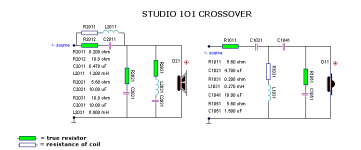The extra woofer will give you +6dB sensitivity over the low end where it should be used. Is the tweeter currently attenuated by at least that much? If so you can bring it up. Sometimes this can be done easily enough without affecting the response slope/phase, other times it may be more complicated. You'll need to undo the existing baffle compensation, not sure how simple it will be to retain the existing woofer response at the crossover. Essentially yes, it should be re-done.
You have to redesign the woofer section of the crossover.Would it be as easy as rolling a second 8542 in at the appropriate place or is there more crossover work required to make this work?
In a 2 way you have a BSC built in the LP filter. In a 2.5 way the lower woofer will roll off at the baffle step frequency, but the upper woofer won't have any BSC, and will have only the LP circuit.
For doing that in the Troel's Studio 101 design you need to lower the main coil, but if you do that you also need to modify the value of the cap in parallel. You need to be able to simulate the effect.
See those designs and in particular the transfer functions:
a 3.5 way design: Zaph|Audio - ZDT3.5 and the transfer function: http://zaphaudio.com/ZDT3.5-transferfunction.gif
a 2 way design: Zaph|Audio - ZRT - Revelator Tower and the transfer function: http://zaphaudio.com/ZRT-2way-modeled-transferfunctions.gif
Ralf
The tweeter section too because now the design is 6dB more sensitive and the tweeter level needs to be adjusted up by 6dB to suit. Depending on the sensitivity of the woofers and tweeter (I haven't checked the driver specs), this may not even be possible.You have to redesign the woofer section of the crossover.
Hi,
Adding 6dB to the tweeter is more than trivial in the 101.
Reducing R1011 reduces the source impedance seen by the
3rd order filter, changing its Q, it must be redesigned to suit.
rgds, sreten.
I remember reading about filter Q in one of my books. How do you discern between what q is desire able and how does it affect sound in practice? My basic understanding is that it creates ringing and energy loss in the filter. Is that correct?
Hey, sreten, where you been, mate? We've missed you!Hi,
Adding 6dB to the tweeter is more than trivial in the 101.
Reducing R1011 reduces the source impedance seen by the
3rd order filter, changing its Q, it must be redesigned to suit.
rgds, sreten.
You're quite right, of course. The conversion to a parallel MTM is not trivial. Series MTM, I can do in my sleep.
Studio-101
I ground out the maths, halving coils and resistances, doubling capacitors in the bass section, and I was struggling to get 6dB gain in the tweeter filter and keep the slopes right, but got there in the end. But the impedance is HORRIBLY LOW.
Box conversion is easy enough. Double the cabinet height and volume, halve the length of the port, but if the tweeter isn't loud enough to your taste, you've got absolutely nowhere to go here IMO.

Troels does an MTM conversion here. He uses a simpler filter, mainly for impedance reasons, I suspect:
Vifa PL14WJ-
Now, TBH, a 2.5 way is different from an MTM, but an even bigger task IMO.
Attachments
- Status
- This old topic is closed. If you want to reopen this topic, contact a moderator using the "Report Post" button.
- Home
- Loudspeakers
- Multi-Way
- Converting a 2way design to 2.5.


